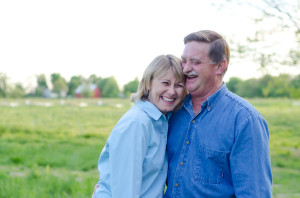About FPF
Norm and Sandy Sutter have a history of farming since they were married nearly 40 years ago. Norm was a grain farmer when Sandy entered his life and she quickly became a farm wife as soon as they said, “I do!” Sandy had very little experience in production agriculture (let’s say she was around the farm life from her aunt and uncle, but that’s about it!). Norm was the one who had the background and education in the field (no pun intended).
Over the years as they worked and raised a family, agriculture was always a part of their life. They grain farmed, had a few cows (and even a few pigs once!), baled hay, etc. over the years. In the 1980’s when many farms went out of business, finding that small-scale farming wasn’t going to make it, Norm and Sandy hung on. As their family responsibilities grew, so did the farms. By 1990, with both of them working full-time off the farm, the tasks were becoming more time-consuming and costly to keep up.
In 1991 they sold all the grain equipment and simplified life to spend more time with their young family. It was at this time that Norm took Sandy to a cattle field day where they learned about Management Intensive Grazing. They came back to the family farm and immediately began planting grass, fence posts and running high tensile wire. The Stockman Grass Farmer, published by Allan Nation, was a regular piece of reading material, quickly replacing Prairie Farmer, Successful Farming and Progressive Farmer. By 1992 they were running stocker cattle, buying 300 – 400 lb. calves from the sale barn in the early part of the year, grazing them over the spring into the fall and then selling them at the sale barn, hopefully around the 800 lb. range.
There was a learning curve in this new adventure as they gained experience in raising grass and working with pasture rotation. Norm and Sandy attended numerous conferences over the years, learning and growing. One important learning point was having fresh water available to all paddocks (small pastures sectioned from the big pastures). They learned the importance of keeping cattle moving with a healthy balance of cattle stocking rate and achieving daily gains. Let’s say not all years were great. Those became “learning experiences!”
The nutritional part of the equation did not enter in until 2006 when Norm and Sandy were building a new home place on the family farm. Friends began asking about grass-fed beef. As stated earlier, this farm was a stocker operation, not a finishing operation. But the more people pressed in, asking about it and offering to buy it if it was produced, the more this deserved investigating. As Norm and Sandy were still in the design stages of the cattle barn anyway, they began reading more about grass-fed beef. Not sure if their acreage could produce enough grass to finish out beef raised solely on grass, they hired Jim Gerrish to spend the day consulting with them, offering ideas and suggestions as well as crunching some numbers on what they could produce and expect on their land. Jim suggested adding chickens and eggs to the land, but Sandy was reluctant to bring anything with feathers onto the property. However, that’s where the story turns!
The more they learned about the nutritional benefits of animals on grass (who were after all, designed by God to be on grass), the more sense it made to work in harmony with nature than against it. By this time articles were regularly appearing in The Stockman Grass Farmer educating grass farmers about the benefits and conference agendas were reflecting this as well!
A severe ice storm on November 30, 2006 brought upwards of 50 trees down on existing fences. Norm and Sandy moved into their new farm home in January 2007. With loads of work ahead in designing facilities and now major repairs needing to be done to existing fences, moving forward would slow down. All by God’s design, though. Based on all the interest in grass-fed beef, the working facilities were now designed to allow for all sizes of animals from small calves to fully grown cows or bulls; something originally not in the plans.
The next couple years were spent finishing up building the cattle lot and handling facilities, planting some new pasture and trying to sell their existing house. Remember at this time there was a housing crisis and major recession going on! Norm and Sandy also had two daughters get married during this time frame, one of whom held their wedding on the new farm!
By 2009, while continuing to educate themselves on the nutritional and health benefits of animals raised on grass, without hormones, antibiotics, etc. Norm and Sandy were joined in their efforts by their son, Wade and his wife, Jaime. A new garden was planted, mostly organic seed and plants with no commercial fertilizers, pesticides or insecticides. They all began looking at lists of ingredients in foods at the stores, reading labels, and understanding the effects on the body from ingredients that cannot even be pronounced! It seemed every direction they turned more supporting information and confirmation was being found to continue in this pursuit of working with nature in according to God’s design.
Wade, Jaime, Norm, Sandy along with some dedicated friends and family members worked all of 2009 putting up new fences and making repairs to the ice storm damaged ones. Pushing Wade to get finished with fencing were 12 cow-calf pairs that were being custom grazed on the farm. Wade began reading books written by Greg Judy, Jim Gerrish, and Joel Salatin. He began trying out the MOB grazing method described by Greg Judy. The Stockman Grass Farmer became a much anticipated monthly publication on the farm! A transformation was happening in the lives of the Sutter Family.
In the summer of 2009 talk began of attending a conference as Wade’s interest grew in being an active part of the farm as opposed to working off the farm. They decided upon the Mid-Atlantic Grass-Finished Livestock Conference which included a tour of Polyface Farms in Swoope, VA. Wade was convinced they could add chickens to the farm and create a cash flow based off of Joel Salatin’s model. Before committing to any of this, the Sutter’s headed for Virginia.
After the conference, the direction was set. The Sutter’s would add pastured chickens and pastured eggs to their cash grazing of beef cattle. Since the cow-calf pairs had been picked up by their owner in the fall, Wade ran an ad on Craig’s List for winter grazing, something the Sutter’s had never done before. This was a trial to see if this model would work on the farm as Greg Judy and Jim Gerrish talk about. Wade immediately received an email from a nearby farmer interested in bringing his cows here. It worked beautifully, even with one of the hardest winters in the St. Louis area in many years. From December to spring, the cows only spent a couple weeks here and there in the lot eating hay; otherwise they were on pastures, rotated every day!
Over the winter plans were made to launch a direct-marketing farm business where pastured eggs and chickens would be sold to the public. Fresh Pasture Farms, LLC would be the name as it describes so perfectly the vision for each animal on the farm. Every morning the chicks, chickens, pigs, turkeys and cows are moved to a fresh pasture of grass where they receive a variety of grasses, sunshine, and custom-made feed ration for the chickens, turkeys and pigs as they are omnivores and need more than grass to meet their nutritional needs. In the Fall of 2013, FPF changed the laying and meatbird ration to be non-GMO, and the majority of the ingredients have all been locally sourced within 200 miles.
Fresh Pasture Farms, conveniently located 20 minutes southeast of downtown St. Louis, in the beautiful farm country of St. Clair County, IL, is open every Saturday from 9 a.m. to 3 p.m., Tuesdays from 1 p.m. to 5:30 p.m., and Thursdays from 1 p.m. to 5:30 p.m. for families to experience a real working pasture-based farm. Eggs are available year-round. Pre-orders for fresh chicken, turkey, and pasture-raised pork are available seasonally. The Sutter’s look forward to meeting anyone interested in learning more.
Everyone is encouraged to investigate the source of their food and to buy locally. Be an educated consumer and know that there IS a difference on how your food is raised. It does affect the nutritional value (and your health) more than you know!

